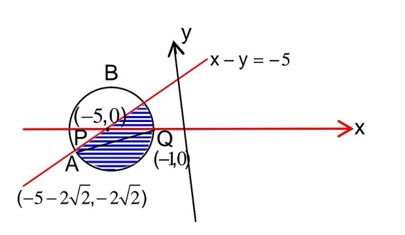Complex Numbers and Quadratic Equations
Get insights from 193 questions on Complex Numbers and Quadratic Equations, answered by students, alumni, and experts. You may also ask and answer any question you like about Complex Numbers and Quadratic Equations
Follow Ask QuestionQuestions
Discussions
Active Users
Followers
New answer posted
a month agoContributor-Level 10
.(1)
–2α + β = 0 …(2)
Solving (1) and (2)
a = 1
b = 2
-> a + b = 3
New answer posted
a month agoContributor-Level 10
Given : x2 – 70x + l = 0
->Let roots be a and b
->b = 70 – a
->= a (70 – a)
l is not divisible by 2 and 3
->a = 5, b = 65
->
New answer posted
a month agoContributor-Level 10
z1 + z2 = 5
⇒ 20 + 15i = 125 – 15z1z2
⇒ 3z1z2 = 25 – 4 – 3i
3z1z2 = 21– 3i
z1⋅z2 = 7 – i
(z1 + z2)2 = 25
= 11 + 2i
= 121 − 4 + 44i
⇒
⇒ = 117 + 44i − 2(49 −1−14i )
= 21 + 72i
⇒
New answer posted
2 months agoContributor-Level 10
(2 – i) z = (2 + i) , put z = x + iy
(ii)
x + 2y = 2
(iii)
Equation of tangent x – y + 1 = 0
Solving (i) and (ii)
Perpendicular distance of point from x – y + 1 = 0 is p = r
New answer posted
2 months agoLet z be those complex numbers which satisfy
If the maximum value of then the value of (a + b) is…….
Contributor-Level 10
->Represent a circle
->Represent a line X – y
So max |z + 1|2 = AQ2
Hence a + b = 48

New answer posted
2 months agoContributor-Level 10
Given n = 2x. 3y. 5z . (i)
On solving we get y = 3, z = 2
So, n = 2x. 33. 52
So that no. of odd divisor = (3 + 1) (2 + 1) = 12
Hence no. of divisors including 1 = 12
New answer posted
2 months agoContributor-Level 10
circle with radius = 3
arg part of a circle (with radius ). no common points
Taking an Exam? Selecting a College?
Get authentic answers from experts, students and alumni that you won't find anywhere else
Sign Up on ShikshaOn Shiksha, get access to
- 65k Colleges
- 1.2k Exams
- 679k Reviews
- 1800k Answers
